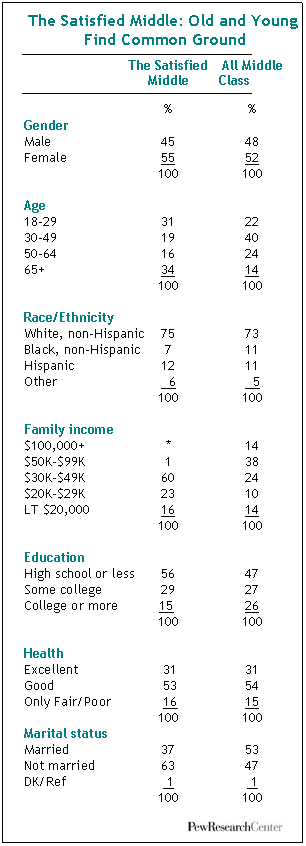25% of the middle class; 12% of all adults
The optimism of youth and the contentment that comes with old age together define this group and make them distinctive from the other three middle class groups analyzed in this study. About a quarter of those who identify themselves as middle class are in the Satisfied Middle, or about 12% of the country as a whole.
Retirement-aged adults and twentysomethings are overly represented in The Satisfied Middle. But on several core issues, there’s no generation gap for these self-described middle class Americans. On virtually every measure of life satisfaction these self-described middle class Americans consistently rank at or near the top. For older members of the Satisfied Middle, these views may reflect the contentment that comes after a long and successful life, while for the younger members of this group, the survey suggests these views reflect the confidence and optimism of young people.
These middle class Americans prove you don’t need money to be happy: Even though they rank third out of the four groups in terms of median family income—the older people because they disproportionately are living on fixed incomes, the young because they’re still a decade or two from their peak earning years – nearly half (47%) say they’re living comfortably compared with 39% of all middle class Americans.
Who They Are
 The Satisfied Middle is both disproportionately young and disproportionately old, and this striking age distribution is their single most defining demographic characteristic. Fully a third (34%) are 65 and older; that’s more than double the proportion of seniors in any of the other groups. At the same time, nearly as many (31%) are under the age of 30, the second highest proportion of any of the four groups. A majority are women (55%), in large part because women outnumber men among older adults.
The Satisfied Middle is both disproportionately young and disproportionately old, and this striking age distribution is their single most defining demographic characteristic. Fully a third (34%) are 65 and older; that’s more than double the proportion of seniors in any of the other groups. At the same time, nearly as many (31%) are under the age of 30, the second highest proportion of any of the four groups. A majority are women (55%), in large part because women outnumber men among older adults.
This age duality is reflected in characteristics of this group. Nearly four-in-ten (39%) are retired, most of any group. At the same time, one out of five in the Satisfied Middle are students. As is true generally of older people, fully half the homeowners in this group have paid off their homes (57%). That’s about double the proportion in the middle class as a whole.
Despite their contented outlook, these Satisfied Middlers don’t earn a lot of money. Half (52%) have family incomes between $20,000 to $40,000. That’s nearly three times the percentage of all middle class Americans. More than eight-in-ten (84%) earn $20,000 to $50,000. Fully four-in-ten (41%) receive Social Security or some other form of retirement benefit, nearly double the proportion of others in the middle class.
Attitudes toward money reflect the age skew of this group. Overall, members of the Satisfied Middle are the second most likely to value wealth, largely reflecting the disproportionately large number of young people, who, as a group, want to be rich.
What They Think
Personal progress also defines this group, and by their own accounts, they’ve come a long way. Those in the Satisfied Middle are, with those in the Top of the Class, the most likely to say they’re doing better than their parents: fully 45% say they’re doing “much better” than their parents did at a similar age, a view held by both the youngest and oldest members of the Satisfied Middle. Nearly nine-in-ten (88%) say they live comfortably or meet expenses with a little left over; only 12% report they just meet expenses or fall short each month.


